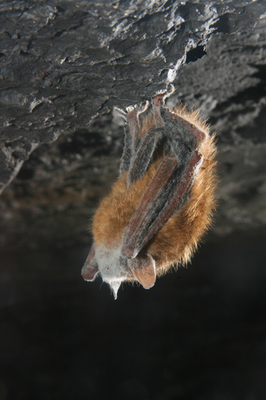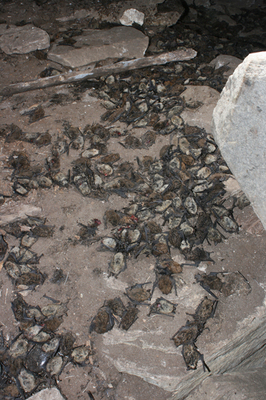
by Mary Caperton Morton Thursday, January 5, 2012

A little brown bat with a white muzzle characteristic of White Nose Syndrome. Alan Hicks

Dead bats liter the floor of Aeolus Cave near Manchester, Vt. Alan Hicks
These are dark days for bats. Hundreds of thousands of tiny white-nosed bats have died over the past few winters, falling to cave floors across the eastern United States. The killer is White Nose Syndrome, a mysterious disease inflicted by an unusual cold-loving fungus that attacks bats while they are hibernating. Come spring, as few as 5 percent of the bats in heavily infected roosts are still alive.
East Coast hibernating bats may already be doomed. So far, upward of 2 million bats have been killed by White Nose Syndrome, a loss wildlife experts characterize as “catastrophic” and “unprecedented since the passenger pigeon.” At the current rate, the once common little brown bat is projected to be regionally extinct in a matter of years, and five other species of eastern bats face similar bleak fates. The prognosis could get even worse: The disease is spreading westward at an alarming rate.
In response to the crisis, bat research has exploded — more has been learned about hibernating bats in the past five years than in decades prior — as bat ecologists, wildlife pathologists and cave microbiologists scramble to figure out how to quell the onslaught. But whether they will learn enough about this mystifying disease in time to save the bats remains to be seen.
Bats are one of nature’s great success stories. More than 1,100 species populate the planet, accounting for 20 percent of all classified mammal species. The majority of bats hunt insects at night, using a sophisticated form of echolocation. They have virtually no predators and until recently, appeared remarkably disease-resistant, with some bats living for 20 years or more.
Then in February 2007, Alan Hicks, a wildlife specialist with the New York State Department of Environmental Conservation, based in Albany, received an unsettling phone call. Colleagues conducting a routine bat survey in nearby Hailes Cave had found so many dead bats that they couldn’t take a step without hearing bones crunch underfoot.
“Seeing that first cave really shook me up,” Hicks says. “I’ve been visiting [Hailes] for 30 years. It’s always full of thousands of bats and all of a sudden it was virtually empty of anything alive.”
The dead bats and the few still clinging to life on the roof and walls of the cave all had strange white spots on their wings and muzzles encased in white fuzz. Hicks snapped a few photos and sent them out to every bat person he knew. “Nobody had seen anything like it before,” he says.
Hicks and colleagues held out hope that whatever was killing bats in Hailes Cave was a one-time fluke, but by the following winter, every known cave within 120 kilometers was littered with dead bats covered in white fuzz.
In the spring of 2008, bat researchers from across North America gathered in Albany for an emergency national meeting. “The meeting didn’t do the bats much good, but at least we were wringing our hands in unison,” Hicks says. “By then it was apparent that something dreadful was happening to bats on our watch.”
© 2008-2021. All rights reserved. Any copying, redistribution or retransmission of any of the contents of this service without the expressed written permission of the American Geosciences Institute is expressly prohibited. Click here for all copyright requests.